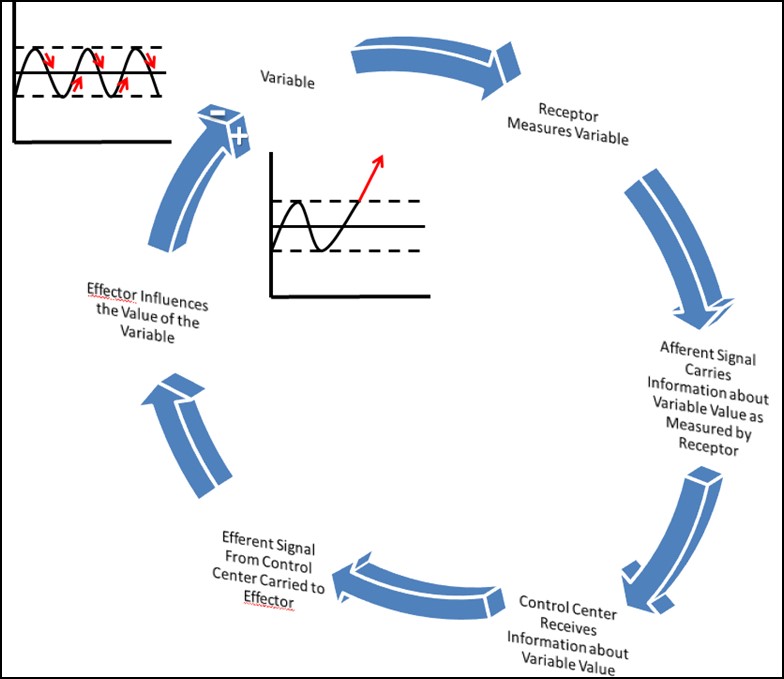HOMEOSTASIS FEEDBACK RESPONSE LOOPS
FEEDBACK RESPONSE LOOP
Homeostatic control systems, like the temperature example above, generally result in Feedback response loops. Feedback response loops start as stimulus that changes a variable and ends with an effector that changes the variable. If the variable is changed in a way that brings it back towards set point, we call it negative feedback. We use the word negative to indicate that the resulting change in the variable is opposite of the initial change. In other words, if a stimulus were to cause the temperature variable to be increased to 99°F, the response of sweating would act to decrease the variable back to 98.6°F. Since the initial stimulus caused an increase in temperature and the resulting response was a decrease in temperature we call the whole process a negative feedback loop. Regulation of body temperature is only one of many examples of how the body maintains the constancy of the internal environment. Other negative feedback loops that regulate homeostasis include replenishment of oxygen by the lungs, the regulation of the pH of the blood at 7.4, and the regulation of blood glucose by insulin; but, keep in mind that there are many other examples.
Sometimes the response to a stimulus results in a change to the variable that increases the deviation from the set point. This type of mechanism is called a positive feedback loop. Most of the time positive feedback loops are the result of negative feedback systems that do not adequately correct the problem. For example, in response to a substantial loss of blood, the blood pressure would drop and the negative feedback response would be to increase the heart rate to help return blood pressure to normal. However, if the loss of blood was too great, the increase in heart rate might not be adequate to increase the blood pressure, and as a result, less blood would go to the heart. Since blood carries essential oxygen and nutrients, less blood to the heart would essentially starve the heart. This would result in loss of function, and weaker contractions resulting in less blood being pumped, which would result in less blood to the heart and so on. Thus, because the negative feedback response (an increase in heart rate) was not adequate, the end result was that blood pressure continued to drop. This situation would require intervention from a medical professional to save the individual.
There are a few examples where positive feedback mechanisms are good. For example, during child birth, labor contractions are enhanced through positive feedback. This is the result of a hormone called oxytocin which is released from the brain during labor contractions. Oxytocin enters the blood stream from the brain and circulates through the blood to the uterus where it causes more powerful contractions. Contractions of the uterus push the baby's head downward which stretches the cervix. Stretch receptors in the cervix and uterus then send signals to the brain to release more oxytocin and this positive feedback system continues until birth is accomplished. You may have heard of the drug pitocin; this is a synthetic form of oxytocin that can be injected into expectant mothers to induce labor or assist contractions when the oxytocin system is not functioning naturally.

Above is an image representation of a Feedback Response Loop. Notice that feedback loops can result in Negative or Positive Feedback. The red arrows in the top left graph always show what would happen if the effector(s) always caused the variable to come back to set point (Negative Feedback). The red arrow in the right hand graph (inside the cycle) shows what would happen if the effector(s) always caused the variable to go further and further from set point (Positive Feedback).
**You may use the buttons below to go to the next or previous reading in this Module**

